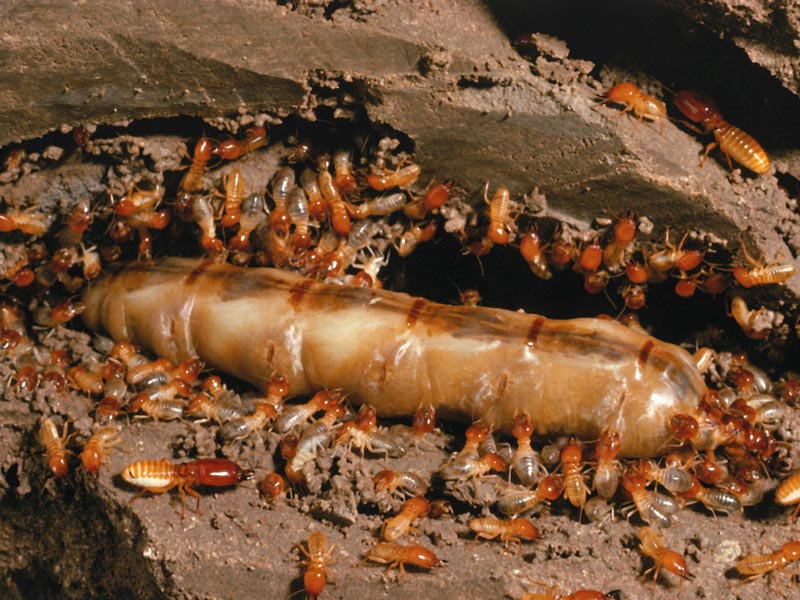
What Do Termites Eat? Can Termites Eat Hardwood?
What do termites eat? Well, it’s a lot more than just wood. That’s the scary bit. At Allstate Pest Control, we’ve been into pest control in South Australia since 1986, and we’ve seen enough about these destructive insects.
We’ve seen homes around Adelaide where skirting boards crumble like Weetbix. Fences eaten from the inside out. Even cardboard boxes in storage that look like lace. Termites are silent eaters, and once a termite colony is active, they’ll chew through anything with cellulose.
And here’s the thing: most termite infestations go unnoticed until there’s already significant structural damage.
Whether it’s subterranean termites building mud tubes from your garden bed or drywood termites burrowing into your window frames, their feeding habits don’t stop. That’s why we recommend annual termite inspections for most homes in Adelaide. It’s the most practical way to detect termite activity early and avoid massive repair bills.
Let’s break down exactly what termites eat, what they don’t and all the myths you probably may have heard of.
8 Facts and Myths About Adelaide’s Most Destructive Insect
1. Can termites eat hardwood?
Yes. People in Adelaide often think hardwood is safe from termites, but the opposite is true. The majority of termites actually prefer hardwood over softwood, even though it takes them a little longer to eat and process.
2. Do termites live out in the open?
No. Subterranean termites (the termite common in Adelaide) travel through tunnels known as mud tubes which they make out of their own excrement and saliva. Termites need a high level of humidity to survive which is why they don’t venture out into the open.
3. Do termites eat 24 hours a day?
Yes. The majority of a termite colony consists of workers who work day and night eating wood to provide food for the colony.
4. If your house has been treated for termites, will you ever need another inspection?
Yes. Termites can and will return to the area, so it’s important you keep up with annual inspections to stop them at the very earliest sign.
5. Do DIY termite treatments work?
No. DIY treatments are highly inadvisable for a couple of reasons. First, DIY treatment chemicals are nowhere near as strong as they need to be. Second, even with the right chemicals, only a professional with the right experience is equipped to appropriately target infested areas without putting you and your family at risk.
6. Are termites easy to spot?
No. Once you have a heavy infestation, you may notice hollow-sounding walls on small piles of insect wings. Still, it’s almost impossible to know there’s a young colony in your house without a professional inspection.
7. Do black ants eat termites?
Yes. Black ants can attack and eat termites if given the opportunity, however this is rare: termites are rarely hanging around above ground with black ants, instead sticking to their mud tubes and the insides of your walls.
8. Do steel-framed houses stop termites?
No. Fortunately termites can’t eat steel. So, steel-framed houses certainly aren’t as susceptible to attack. However termites can still feed on any other timber parts of the house such as window frames, floor boards, fixed timber furnishings and timber fences and pergolas.
Frequently Asked Questions
Why do termites eat wood so much?
Termites eat wood because it’s rich in cellulose, their primary food source. Inside their gut, specific microbes help break it down for energy. Worker termites do most of the feeding and share nutrients with the rest of the termite colony. It’s why timber homes are such a feast for these destructive pests.
Do termites eat pine or only hardwood?
Yes, termites eat pine. While some hardwoods like jarrah are more termite-resistant, softwoods like pine are an easy target. Subterranean termites, especially those found in pine, love moisture-rich landscaping timbers and wall frames. Once damp, it becomes an ideal buffet.
What do most termites eat in Australia?
In Australia, termites mainly feed on dead or decaying timber, untreated wood, paper, cardboard, and even some fabrics. Subterranean termites are the most common species here and are known for attacking house frames, fence posts, and even bookshelves. If it’s cellulose-based, they’ll feed on it.
What do termites hate the most?
Termites hate dry environments, direct sunlight, and certain strong smells like vinegar, orange oil, and neem. They thrive in dark, damp spaces where mud tubes can stay moist. Regular ventilation, clearing garden beds near walls, and fixing leaks quickly can discourage termite survival.
What kills termites the fastest?
For fast results, chemical treatments like termiticides applied by licensed termite control technicians are most effective. These solutions create a treated zone around the property or directly target the termite nest. For serious infestations, baiting systems also work by attracting termite workers who unknowingly share the poison with the rest of the colony.
So, how is your termite knowledge?
Are you a budding termite inspector, much less informed than you would like, or somewhere between the two? Let us know how many of these you already knew and if there were any that surprised you.
If your new-found knowledge has got you anxious to get your house inspected, our friendly team can get you booked in as soon as it suits you. Click the orange chat button or call 8371 1277.



